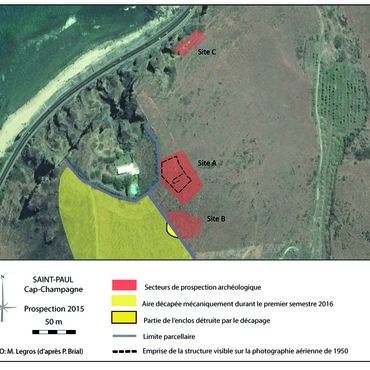
- Home
- Archaeology on Reunion Island
- Sites
- Saint-Paul
- Cap Champagne
- Cilaos
- La Possession
- Saint-André
- Saint-Benoît
- Saint-Denis
- Saint-Joseph
- Saint-Leu
- Saint-Louis
-
Saint-Paul
- Bassin Vital
- Batterie “De Droite"
- Batterie “De l’Embouchure"
- Cap Champagne
- Chemin de Bernica
- Marin cemetery
- Colline du Théâtre
- Domaine de Villèle
- Eastern entrance, Section 3
- Glacières du Maïdo
- Plaine-aux-sables
- Plateau Picard
- L’Étang bridge
- Poudrière
- Route des premiers Français
- Bruniquel factory, indentured workers’ camp and hospital
- Usine de Grand Fond
- Saint-Pierre
- Saint-Philippe
- Sainte-Rose
- Sainte-Suzanne
- Salazie
The remains of a coastal settlement were found at Boucan-Canot, on Cap Champagne hill, in Cap de La Houssaye.
One of the first properties on the island
In 1668, the Compagnie des Indes orientales awarded a concession to the settler Gilles Launay which corresponds to the location of these remains on Cap Champagne. He built a habitation where he bred livestock. The built remains in Area 2 include quadrangular structures, building foundations and a section of perimeter walls.
Launay’s heirs, the Aubert family, are thought to have sold their home in the 18th century to the government, which built a lookout on the site.
Remains of a lookout
The lookout posts set up around the coast from the 18th century were designed to give advance warning of an attack from the sea. The lookout on Cap de La Houssaye was built between 1793 and 1796. It was composed of a large house with a kitchen and a signal mast. Archaeological research – surveys in 2015 and test pits in 2016 – concentrated on one section of these remains and revealed evidence of this habitation. The finds are typical of 18th and early 19th century domestic life.
Associated media
Open Media Library

Aerial photograph (Saint-Paul, Cap Champagne, 1950)

Secteurs de prospection (Saint-Paul, Cap Champagne, 2015)

18th century map

View of the excavation (Saint-Paul, Cap Champagne, 2016)

General map (Saint-Paul, Cap Champagne)

Remains of a building (Saint-Paul, Cap Champagne, 2016)

Remains of a low wall (Saint-Paul, Cap Champagne, 2016)

Kitchen (Saint-Paul, Cap Champagne, 2016)

Crockery (Saint-Paul, Cap Champagne)

Pipe sherds (Saint-Paul, Cap Champagne)

